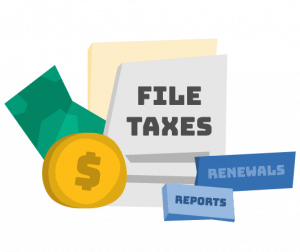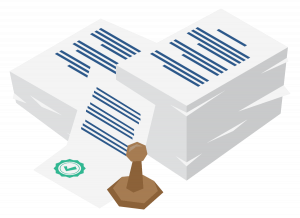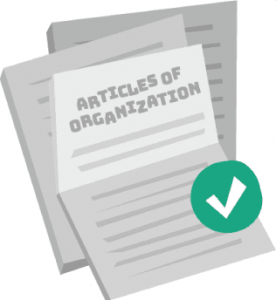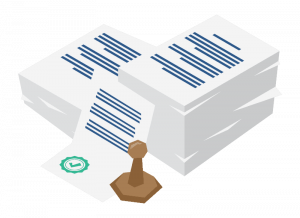Start a Business in Minnesota
How do you start a business in Minnesota? Simply selling something or offering services by yourself makes you a sole proprietor. But to actually make money and protect your assets, you’ll need to do more. Though Minnesota has a pretty steep corporate tax rate of 9.8%, the Greater MN Job Expansion Program offers sales tax refunds for long-standing businesses. To learn more about how to grow and form a business in Minnesota, keep reading this complete starting a business in Minnesota guide. Let's get started.
When You Want More
$39 + State Fees
When we form your company, you get everything you need to start your business from scratch.
- Business Entity Formation
- Business Phone Service and Email Address
- Website and Web Hosting
- SSL Security
- Domain Name
- Privacy by Default®


1. Pick a Business Structure
If you’re out there selling doughnuts or doing freelance photography all by yourself, and you haven’t registered with Minnesota, you’re a sole proprietor. Sole proprietorships and general partnerships don’t offer you any distinction between yourself and your business. And without a distinction, you have no liability protection. Minnesota LLCs and corporations, on the other hand, are separate business entities that offer you the protection you need.
Minnesota Limited Liability Company (LLC)
A Minnesota limited liability company (LLC) is a business entity that offers liability protection. LLCs also offer you flexibility in choosing how your business is taxed or managed. You can chose whether your LLC is managed by you or by a hired manager or managers. Starting a Minnesota LLC requires filing Articles of Organization ($135-$155, depending on how you file) with Minnesota’s Secretary of State.
Minnesota Corporation
While LLCs are more flexible than corporations, corporations are often more attractive to investors due to their record-keeping requirements and government oversight. Corporations are owned by shareholders who invest money in exchange for ownership in the company. The shareholders of the company appoint a board of directors who elect officers to run the company. To form a Minnesota corporation, you’ll need to file Articles of Incorporation ($135-$155, depending on how you file) with the Minnesota Secretary of State.
Can an LLC be just one person?
Of course! A one-person LLC is called a single-member LLC, sometimes referred to as an SMLLC. Single-member LLCs are one of the most common kinds of businesses in the country. For the most part, single-member LLCs are very similar to multi-member LLCs; however, there are a few notable differences. For example, SMLLCs are taxed as sole proprietorships, and multi-member LLCs are taxed as partnerships.
Read all about Single-Member LLCs.
What about a Minnesota nonprofit?
Thinking about starting a nonprofit in Minnesota? You can start a nonprofit to pursue a purpose that benefits the public or a certain group. Nonprofits are managed by a board of directors. As a nonprofit, you can apply for your business to be tax-exempt by filing forms with the IRS. To start a Minnesota nonprofit corporation, you’ll have to file the Minnesota Nonprofit Corporation | Articles of Incorporation Application with the Minnesota Secretary of State ($70-$90).
Want to learn more? Check out our Nonprofit Guide.

2. Name Your Business
Naming a business isn’t straightforward. But don’t worry, we break down Minnesota’s naming requirements for you. If you’re a sole proprietor, your business name is your personal name, unless you register a DBA.
Basically, your business name must:
- Use an appropriate identifier or abbreviation like “corporation,” “Company,” or “Inc.” for corporations or “limited liability company,” “limited company,” or “LLC” for LLCs.
- Not mislead the public about the nature of the business.
- Be unique in the state of Minnesota.
Find out if your desired name is available in Minnesota by searching the Minnesota Online Business Services database.
Can I reserve a business name in Minnesota?
Yes! To reserve a business name in Minnesota, file an Application for Name Reservation | Request for Reservation of Name. The filing fee is $55 for online and in-person expedited service and $35 for filing by mail.
What is a DBA?
DBA stands for “doing business as.” In Minnesota, DBAs are referred to as assumed names. DBAs allow owners to conduct business publicly under a different name than their legal name or the business’ legal name. Your business’ legal name is the one you list on your formation documents. If you’re a sole proprietor, your business name is your legal name. To get a DBA in Minnesota, you’ll file a Certificate of Assumed Name with the Minnesota Secretary of State. The filing fee is $50 for online and expedited filing and $30 for submitting by mail.
Learn how to get a DBA in Minnesota.
What about trademarked names?
It’s a good idea to check with the US Patent and Trademark Office (USPTO) to make sure your business name hasn’t been trademarked by someone else. If it has, and you use it anyway, there’s a chance that you could be sued for infringement.

3. File Formation Paperwork
Sole proprietors and general partners don’t need to file formation paperwork in Minnesota unless they are using a DBA. That’s because sole proprietorships and general partnerships aren’t separate business entities.
LLCs and corporations, however, are required to file paperwork with the Minnesota Secretary of State before they conduct business in the state.
- To form a Minnesota LLC, file Minnesota Articles of Organization ($135-$155)
- To start a Minnesota corporation, file Minnesota Articles of Incorporation ($135-$155)
The filing fees for each depend on how you file—in person and online filings are automatically expedited and charged $155. Mailed filings cost $135. Both of these forms require you to list a Minnesota registered agent to receive your legal mail.
Note: The information you list on those forms becomes a part of the public record once your filings are accepted. This means your name and address will be available online on the Minnesota Secretary of State website for anyone to find by searching your business name.
How can I keep my information off the public record?
To keep your information off the public record in Minnesota, your best bet is to hire a registered agent. Registered agents can list their address and name on your filings where applicable. (Hint: we do that!)
Learn how to get a business address.
What is a registered agent?
A registered agent is a person or entity responsible for receiving state and legal mail on behalf of your business. By law, your registered agent is required to have a physical address in Minnesota where they’re present during business hours to accept service of process for your business. Many business owners find it is easier to hire a service, like Northwest, to handle this process and give them the freedom to operate their business wherever.

4. Draft Internal Records
So far in this guide, we’ve dealt with public forms that you’ve had to file with the Minnesota Secretary of State. Now, it’s time to organize your internal records. These are the documents your business will keep on record within your company.
Though these documents are internal, you’ll likely need to show them to third parties like the bank or—if you start a nonprofit—the IRS.
Here are the major internal documents you need to organize for LLCs and corporations:
Minnesota LLC Operating Agreement
This is your LLC’s rule book. It defines how your LLC will do things like make decisions, distribute money, manage operations, and appoint officers. Your operating agreement plans for every big picture scenario your LLC is likely (or unlikely) to face, including dissolution.
Drafting an operating agreement is hard, and the internet is full of shabby templates that have been copy and pasted from who knows where. So we had our attorneys draft a Minnesota LLC Operating Agreement template that you can use as a solid foundation.
Minnesota Corporate Bylaws
Bylaws are the rules your corporation will adopt and follow internally. Bylaws detail how your corporation will appoint directors and officers, hold shareholder and board meetings, and handle emergencies, among other things. Like operating agreements, corporate bylaws are not required by law in Minnesota (see MN Stat § 302A.181).
As with operating agreements, you can find plenty of bylaws templates online. But bylaws are pretty serious, so you don’t want to just use the first template you come across. Our attorneys drafted a Minnesota Corporate Bylaws template you can use to get started.
Starting a nonprofit? Learn about Minnesota nonprofit bylaws.

5. Get Minnesota Business Licenses
Not every business in Minnesota needs a license because there is no general state license to run a business. Though some industries, like a midwife business, will need to file with the state licensing board to conduct business. Here are the most common business licenses you may need in Minnesota:
Minnesota State Business License
Minnesota does not have a state-wide licensing requirement for business owners. You will, however, need to check with zoning boards and get approved if you plan on opening a physical location. In St. Paul, for example, you’ll need to file a Zoning Summary Sheet if you want to build a location for your business.
Professional Business Licenses
Professional services are ones that require specialized training or education to perform safely, like attorneys, doctors, and even sports agents. Despite not requiring a Minnesota state business license, the Secretary of State does require certain professions to get licensed by the board regulating their industry. For example, the Minnesota Board of Behavioral Health and Therapy gives licenses for professions like clinical counselors and drug counselors. Each board has its own licensing process, so be sure to check what you will need.
Local Business Licenses
To get your local business license, you’ll need to reach out to either your city’s licensing department or the city clerk. In Minnesota, local governments sometimes require businesses in their jurisdiction to get a general business license. For instance, if you operate a company in Northfield, you don’t need a general business license, but in Hopkins you do.
Learn more about How to Get a Business License.
How do I get a Minnesota local business license?
By contacting your local city or county’s licensing board or clerk, you can get your Minnesota local business license. Many will allow you to file online.
How much does it cost to get a Minnesota local business license?
It all depends on what city or county you get your license in and your industry. For example, in Hopkins, video arcade businesses pay $15 for a general business license, while motels and hotels pay $5.50 per room.
How do I get a professional license in Minnesota?
To get a professional license in Minnesota, you will need to contact the board in control of your industry. For example, you would need to contact the Minnesota Emergency Medical Services Regulatory Board if you wanted to get your ambulance service license.

6. Organize Your Money
The liability protection you get from forming an LLC or corporation is only as strong as the separation between you and your business. At a minimum, you’ll need to open a bank account for your business. And if you’re going to hire employees, you’ll need to tackle payroll, too. Below, we get into what you need to know to organize your Minnesota business’ money in a way that works for you.
Open a Business Bank Account
To keep your business spending separate from your personal spending, you’ll need to open a business bank account. If you don’t, a court could find that your business is not actually separate from you, under the Alter Ego Doctrine. Also known as piercing the corporate veil, this is the outcome when a judge finds that a company is not a separate entity but rather an alter ego of the owner. If this ever happens, you could lose your limited liability status.
Opening a business bank account as a sole proprietor is important, too. Though sole proprietors and general partnerships have no limited liability status to protect, both will benefit from organizing their business finances come tax season.
How do you set up a business bank account?
LLCs and corporations will need to provide the bank with their formation documents, operating agreement or corporate bylaws, EIN, and in some cases, a Corporate Resolution to Open a Bank Account or LLC Resolution to Open a Bank Account.
Do I need a business bank account to accept credit card payments?
Probably. Payment processors require you to provide them with a bank account. This is where they’ll deposit funds from transactions. Most of the time, this needs to be a business bank account.
Some payment processors may let you get away with listing a personal bank account, but it’s not a great idea. Mixing your business finances with your personal finances erodes the separation between you and your business, weakening your liability protection. It also turns tax season into a nightmare.
Learn more about Payment Processing.
Set up Payroll
Processing payroll is a necessary evil for business owners who want to hire employees. But you can bet Northwest is here to break the payroll process down. To set up payroll in Minnesota, you’ll need to:
- get an EIN
- register your business with the Minnesota Secretary of State
- get a Minnesota tax ID
- get a Minnesota Unemployment Insurance Employer Account
- determine whether you’re hiring employees or independent contractors
- prepare the forms your employees will fill out
- choose a payroll service or software
- decide on a payroll schedule
Payroll doesn’t just stop there, though. You’re going to need a reliable and secure payroll service, system or software to keep track of employee payments. A good payroll system will withhold payroll taxes, file state and federal returns on your behalf, and pay your employees either by check or direct deposit.
What forms do my employees need to fill out?
Your new employees will need to fill out a W-4 to determine how much you’ll withhold and an I-9 to verify that the employee is eligible to work in the US.
What’s the difference between an independent contractor and an employee?
It’s important to understand the difference between an independent contractor and an employee. That’s because, for employees, you’ll need to withhold and pay income, social security, and Medicare taxes. Independent contractors pay these taxes on their own.
An independent contractor is self-employed and not an insured member of your employee base. Independent contractors are held to a contract for a specific type of work or project, usually with a specified end date or target budget. An employee is hired by your business as a regular full- or part-time employee insured through your business and required to follow your internal documents, handbooks, and operating practices. You can file Form SS-8 with the IRS and let them decide if you are unsure.
Learn more about hiring independent contractors.
How do I get a Minnesota Tax ID?
You’ll file for a Minnesota Tax ID online through the Minnesota Department of Revenue e-services portal. There is no fee.
How do I get a Minnesota Unemployment Insurance Employer Account?
To get a Minnesota Unemployment Insurance Employer Account, you’ll need to sign up for free online through the Minnesota Unemployment Insurance website.

7. Get Business Insurance
Forming an LLC or corporation protects your personal assets. But if anything disastrous befalls your business—like a lawsuit, burglary, flood, or fire—your business is on the hook to pay. Business insurance can help cover the costs. While you don’t need business insurance in Minnesota, workers’ compensation insurance is required. Let’s dive into the most common types of business insurance:
Workers’ Compensation Insurance
Workers’ compensation insurance pays out medical and wage benefits to employees when they suffer injuries or illnesses on the job. Minnesota has a mandatory coverage law that states all employers are required to have workers’ compensation insurance. Many insurance companies or agents offer workers’ compensation insurance policies along with other kinds of business insurance. Not having workers’ compensation insurance will cost you up to $1,000 each week per employee.
Liability Insurance
Liability insurance covers the costs of claims against your business for injuries or damage to the property of others, like clients or customers. This includes medical expenses, legal fees, settlements, and judgments. Whether or not you need it depends on whether your business is likely to be sued and how many assets your business needs to protect. If it’s just you and your computer in your basement, you might feel comfortable skipping liability insurance. Or maybe you won’t. Beyond general liability insurance, you can purchase or add on more specific types, like professional, cyber, commercial, home-based business, or product liability insurance.
Do business owners need workers’ compensation insurance in Minnesota?
No. In Minnesota, business owners are not required to cover themselves on a workers’ compensation plan. It is your decision if you want to get insured in the case of possible work place or work-related injuries.
Do I need business insurance for my home-based business?
Probably. You can’t count on your homeowners’ or renters’ insurance policy to cover damages related to your business. Most insurance companies offer a home-based business insurance plan.

8. Understand Your Tax Burden
Minnesota corporation owners filing as C-corps need to pay a corporation franchise tax. And depending on how you elect you LLC to be taxed, you’ll have to deal with either corporate tax or individual income tax. Here’s what you need to know:
Federal Taxes
- LLCs. Single-member LLC? By default, you’re taxed similarly to a sole proprietor. More than one LLC owner? You’re taxed as a general partnership. Either way, your default tax status is “pass-through,” which means you don’t pay corporate taxes. Instead, your LLC’s owners report profits and losses on their personal tax returns. Good news: Minnesota has a graduated individual income tax rate, which you’ll pay along with the 15.3% federal self-employment tax rate. An LLC can file paperwork with the IRS to be taxed as an S-Corp or C-corp instead.
- Corporations. Corporations are taxed as C-Corps by default. This means that corporations pay the 21% federal corporate tax rate and the 9.80% Minnesota corporate tax rate.
To pay your federal taxes (and take a good deal of the other steps required to start a business), you’ll need to get an Employer Identification Number (EIN). You can apply for an EIN with the IRS or hire us to get one for you.
Do I need an EIN if I’m self-employed?
If you’re operating a sole proprietorship or single-member LLC that doesn’t employ anyone else and you don’t need to file excise or pension plan returns, you don’t legally need an EIN.
However, you can still get one—and you probably should. Otherwise, you’ll have to use your own social security number to do business. Plus, you’ll likely need an EIN to open a business bank account.
How do I get an EIN?
To get an EIN, you can either apply online or file form SS-4 by mail with the IRS. Getting an EIN is free.
Check out our guide to applying for an EIN.
What is an S-Corp?
An S-Corporation is a federal tax election. Registered business entities like LLCs and corporations start out with a default tax status, but can file paperwork with the IRS to be taxed as an S-Corp. Like LLCs, S-Corps are taxed as pass-through entities. Like corporations, S-Corps can make distributions that aren’t subject to the 15.3% self-employment tax.
Learn more about the S-Corp tax election.
What is a C-Corp?
A C-Corporation is the default federal tax election assigned to corporations. Most corporations are taxed as C-corps, but LLCs can also apply for C-corp tax designation by filing paperwork with the IRS. C-corps file federal corporate income taxes and state corporate income taxes (in Minnesota, the corporate tax rate is 9.80%). C-corps can pay their shareholders in distributions, and the shareholders report those profits on their personal tax returns.
Learn more about the C-corp tax election.
Local Minnesota Business Taxes
In Minnesota, different municipalities have different sales and use tax rates. The local sales and use tax rate is usually pretty low. We’re talking 2% max. And in places like Bemidji, the sales and use tax rate is really low at 0.50%.

9. Build Your Business Website
If you want Minnesotans to find your business, they have to be able to find you online. This means you’ll need a website, a business email account, and social media accounts. Don’t worry if you’re not especially tech-savvy—you don’t have to be a web developer or an influencer to establish a robust online presence. You’ll just need the following:
- Domain name. Your domain is the address where your website will live. You’ll want a domain name that is short, unique, local, and—most importantly—available. If your domain is trademarked, you could face legal trouble.
- Domain registrar. Once you’ve decided on a domain name, you’ll want to register it with a domain registrar. Some domains are more expensive than others. Some domain registrars also offer hosting and most will provide you with a business email that includes your domain name (“name@yourbusiness.com”).
- SSL certificate. An SSL certificate signals to your users that your website is secure. If your website will use forms—like a sign-up form or a “contact us” form—an SSL certificate is critical. But even if you don’t use forms, you’ll still probably want one—it allows an encrypted connection, which means your users’ data is transported securely. There are several types of SSL certificates, and you can often get one through your domain registrar.
- Site design. The easiest option is to use a free website creation tool—there are a number of free options available. Most are easy even for a newcomer to use, with styles and built-in templates. For a more custom design, you can hire a web designer to work on your website, but this would be much more expensive.

10. File a Minnesota Annual Report
It’s important to note that in Minnesota annual reports are called annual renewals. All Minnesota businesses are required to file an annual renewal on December 31 of each year. This is just a form that updates the Secretary of State on basic information about your business. You’ll file online or in-person. Only foreign cooperatives ($115-$135) and limited liability partnerships both domestic and foreign ($135-$155) have to pay a fee to file their annual reports.
Read more about How to File a Minnesota Annual Report.
What if I don’t file an annual report in Minnesota?
There are no late fees if you don’t your annual report in Minnesota. Instead, your business will be administratively dissolved or revoked.

Apply for Trademarks
A trademark is a design, symbol, word, phrase, or any combination thereof that represents a brand’s goods or services exclusively. Only some businesses register trademarks.
You can apply to register your trademark with the state of Minnesota or federally with the U.S. Patent and Trademark Office (USPTO). Registering your trademark in Minnesota is cheaper and easier than registering with the USPTO, but doing so only protects your trademark in Minnesota.
You can only register a trademark once you’ve started using it (so slap it on that website you just made), and not all applications are approved. Trademark law is complex, and the strength of a trademark application (and the trademark itself) depends on many factors.
Our attorneys can review your application, offer advice, and prepare and submit the application for you. Check out our Trademark Service.
How do I register a trademark in Minnesota?
To register a trademark in Minnesota, you’ll need to file a Trademark, Service Mark, Certification Mark or Collective Mark application with the Minnesota Secretary of State. The filing fee is $70 for online and expedited in-person service and $50 for filing by mail.
Can I register a trademark before I use it?
No. But you can file an application with the USPTO under Intent-to-Use status. This gets your application in line before you’ve actually used the mark, which could be helpful if you’re worried someone else might register your mark before you’ve had a chance to use it.
For your trademark to become official, you’ll eventually need to show proof that you’re using it. An Intent-to-Use application buys you some time to do that.
Learn more about filing an Intent-to-Use Trademark.
Ready To Start Your Minnesota Business?







